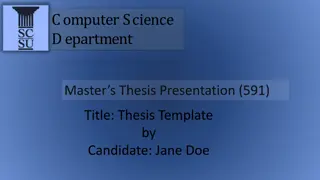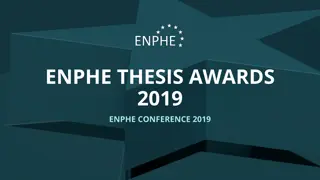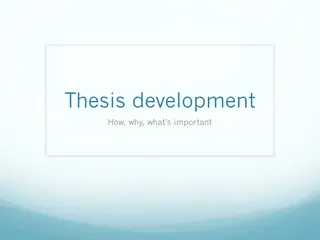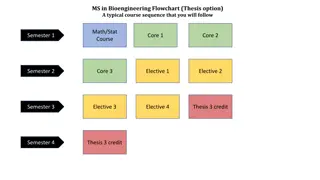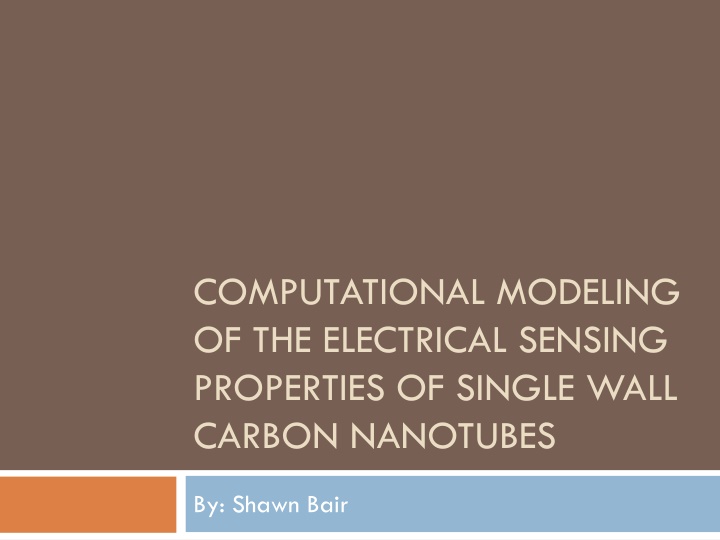
Modeling Electrical Sensing Properties of Carbon Nanotubes
Explore the computational modeling of the electrical sensing properties of single-wall carbon nanotubes by Shawn Bair, covering topics such as preparation, properties, applications, and electrical background in the context of field effect transistors. Discover the structure, synthesis methods, types, properties, and applications of carbon nanotubes, along with their mechanical and electrical characteristics. Learn how carbon nanotubes exhibit unique properties that make them ideal for various practical applications.
Download Presentation

Please find below an Image/Link to download the presentation.
The content on the website is provided AS IS for your information and personal use only. It may not be sold, licensed, or shared on other websites without obtaining consent from the author. If you encounter any issues during the download, it is possible that the publisher has removed the file from their server.
You are allowed to download the files provided on this website for personal or commercial use, subject to the condition that they are used lawfully. All files are the property of their respective owners.
The content on the website is provided AS IS for your information and personal use only. It may not be sold, licensed, or shared on other websites without obtaining consent from the author.
E N D
Presentation Transcript
COMPUTATIONAL MODELING OF THE ELECTRICAL SENSING PROPERTIES OF SINGLE WALL CARBON NANOTUBES By: Shawn Bair
Organization Introduction Carbon Nanotubes Preparation Properties Applications Electrical Background Field Effect Transistors Literature Experimentation Modeling Overview Non-equillibrium Green s Functions Poisson Equation Density Functional Tight Binding Results Conclusions
What are Carbon Nanotubes (CNTs) Discovered by Iijima in 1991. Structure of rolled graphene. Diameter range of 0.4 to 2.0 nm. Synthesis methods include: arc discharge, laser ablation, chemical vapor deposition Formed in various single and multi-walled arrangements.
CNT Types and Naming Convention CNT structure described using two numbers (n,m) A graphene sheet is cut along C C = na + mb This divides CNTs into three groups: armchair, zigzag, and chiral. n=m m=0 n m
Carbon Nanotube Properties Mechanical Properties: Young s modulus of up to 1000 GPa (5x steel) Tensile strength of 63 GPa (50x steel) Weak under compression High diameter (nm) to length (up to cm) ratio Electrical Properties: Enhanced reactive surface Varying properties depending on nanotube type and exposure to molecules Armchair CNTs are always metallic, zigzag and chiral tend to be semiconducting. Metallic conduction occuring when allowed wave vectors pass through region where valence and conduction bands are degenerate High theoretical current density for metallic CNTs
Applications Strong physical properties lead to applications in polymers and materials. Use as tips for atomic force microscopes Conducting bridges in nanoscale electrical systems Appealing due to changes in CNT conductivity resulting from applied forces or exposure to molecules.
Electrical Background Current is the flow of charge carriers. Majority charge carriers can be electrons or holes. Charge transfer from a source contact to a drain. Absorption of dopant molecules on the bridging material can alter the number of charge carriers. Images: http://www.eng.umd.edu/~dilli/courses/enee313_spr09/files /supplement http://www.ceb.cam.ac.uk/research/groups/rg- eme/teaching-notes/introduction-403
CNT Field Effect Transistor (CNTFET) A CNTFET consists of Source and Drain contacts CNT conducting bridge Gate, seperated from system by a dielectric Gate affects energy levels of nearby bands A positive voltage lowers band energy levels. The effect of this depends on the contact fermi level and the material.
Past Experimental Data Kong et al published one of the most often cited examples of CNTs being used as sensors. They measured large changes in conductance upon exposure to NO2 and NH3. CNTs appeared to behave as p-type semiconductors Note: CNTs were exposed to air.
Past Experimental Data Avouris et al discovered that p-type behavior was not intrinsic, but a product of exposure to O2. Annealing at 200 C in vacuum for 10 hours converted CNTs to n type behavior. 3 min exposure to O2 caused reversion to p-type PMMA would protect the n-type qualities from low O2 exposure
Thesis Objectives Model CNTFET system, investigating use as a sensor for gases. Why use modeling? Purchase of CNTs expensive (618$/g), especially for specific types (928$/g). Producing single CNT FETs can be difficult due to the scale Easier to alter conditions then in experiments
How to model the current flow Goal is to find the current flow, I, across the semiconducting CNT bridge at various voltage bias and differing gate voltages Landaur-Buttiker formula states that current is found by e = Electron charge, h = Planck s constant T(E)= Transmission probability fS ,fD = Fermi function of source and drain electrode Need method to find T(E), fS ,fD
Non-Equillbrium Greens Functions (NEGF) Overview Most common system for examining transport at a molecular level. Consists of an iterative process where, given a self consistent potential, Green s functions are used to calculate charge density . Poisson equation, using charge density of system, calculates self consistent potential, UH ,which represents electron-electron and electron-ion interactions Once converged, T(E) able to be calculated
NEGF Setup System first divided into three sections. Source and drain contacts, and extended device region Regions further divided into layers Each layer only interacts with those adjacent to it Contacts assumed to be bulk properties.
NEGF Calculations The goal of the NEGF equations is to find the charge density matrix G< represents the electron-electron correlation matrix, and is equal to The broadening functions, represent the broadened density of states in the device.
NEGF Calculation represents the contacts self energy, which includes effects from the contact. Along with Gr and Ga contains Hamiltonian and overlap terms, which are calculated using density functional tight-binding theory. Once converged
Poisson Equation The electron density from NEGF is expanded into neutral atomic reference densities (ni0) and density fluctuations. Fi00 represents s-orbital like radial function qi represent Mulliken charges, which are related to the electron population on each atom as determined by basis functions.
Poisson Equation Poisson equation for mean field electrostatic potential is A three dimensional version of this equation is used in finding the potential throughout the device space Boundary conditions include Potential falling to zero at large distance Potentials reach bulk set value at contacts or gate This potential is then used in another NEGF loop
Density Functional Tight Binding (DFTB) NEGF and Poisson calculations require a basis set and calculated Hamiltonian (H) and Overlap(S) matrices. These are calculated using Density Functional Tight Binding (DFTB) theory, first proposed by Slater and Koster. Useful due to having good accuraccy and being able to calculate more than the ~100 atoms DFT can reasonably handle
Basic DFTB Linear combinations of atomic orbitals that are orthogonal to orbitals on other atoms are created and used as a basis set. Leads to Kohn Sham equation T represents the kinetic energy term Vext represents electron-ion interactions Vxc represents exchange and correlation potential
Basic DFTB With the orbitals calculated, Hamiltonian matrix elements can be evaluated Two center Approximation made to reduce the computational difficulty H v set to 0 beyond a certain distance Each calculation is broken into smaller pieces, dependent on the type of orbitals and distance. These smaller pieces, once solved, can ideally be used again elsewhere in the calculations
Basic DFTB Energy equation First term represents energies of orbitals Second terms eliminate excess energy from double counting Third term adds energy from exchange and correlation Final term adds ion-ion effects
Single SWCNT Modeling Settings An (8,0) zigzag SWCNT was modeled in DFTB+ to examine the effects of NO2 and NH3 on its conductivity. Modeled system consisted of 224 Carbon atoms, 96 in the central device region and 64 in each contact region. Diameter of 6.27 A Distance of molecules from CNT surface NO2 = 2.18 A Single Molecule placed approximately 0.714 A from CNT length midpoint NH3 = 3.67 Planar Gate, when used, 7 A from center, 7 A long. Placed on opposite side of molecule
Results Gate Variation Gate Variation Effect on Current flow 0.1 V Bias 4.50E-007 4.00E-007 3.50E-007 Current (Amps) 3.00E-007 2.50E-007 Hole Conduction 2.00E-007 1.50E-007 Electron Conduction 1.00E-007 5.00E-008 0.00E+000 -25 -20 -15 -10 -5 0 5 10 Gate Voltage (V) NO2 Doped CNT NH3 Doped CNT
Results Bias Variation I-V Curve at -7 V Gate Voltage 0 0.5 1 1.5 2 2.5 3 3.5 1.00E+000 1.00E-001 Current (Amps) 1.00E-002 1.00E-003 1.00E-004 1.00E-005 1.00E-006 1.00E-007 1.00E-008 Bias Voltage (V) NO2 Doped CNT NH3 Doped CNT
Results NO2 Distance Current at 1 V Bias with Varying NO2 Distance 7.20E-008 7.10E-008 7.00E-008 Current (A) 6.90E-008 6.80E-008 6.70E-008 6.60E-008 0 0.5 1 1.5 2 2.5 3 3.5 4 4.5 5 NO2 Distance from CNT Surface (A)
Conclusions Results appear to be qualitatively as expected, with CNT performing as an n-type semiconductor, and molecules as appropriate dopants. Conduction of CNT able to be modified using gate. Noticible change observed in single NT from just one molecule (3-4 atoms) added to 96 atom device region. Not as large change in two CNT system. Quick calculation times at low bias and gate voltage. Some difficulty with convergence at high values, large systems, more atom types.
Conclusions-Further Applications Modeling metal contacts into system Chosen metal for contacts in nanoscale electronics can have very large effects More heavily doping the device region Simulating exposure to air and O2 groups.
References Iijima, S. Helical microtubules of graphitic carbon. Nature. 1991,354, 56 58. Koskinen, P. Computational Modeling of Carbon Nanotubes. [Online] Carbon Nanotube Hierachial Composites for Interlaminar Strengthening. Aerospace Engineering Blog. [Online] May 11, 2012. Lieber, C. Carbon nanotube atomic force microscopy tips: Direct growth by chemical vapor deposition and application to high-resolution imaging. PNAS. 2000, vol .97, no.8, 3809-3813 Field effect Transistors. Nanointegris. [Online] http://www.nanointegris.com/en/transistors
References M K Achuthan K N Bhat (2007). "Chapter 10: Metal semiconductor contacts: Metal semiconductor and junction field effect transistors". Fundamentals of semiconductor devices. Tata McGraw-Hill. pp. 475 ff. ISBN 007061220X. B. Aradi, B. Hourahine, and Th. Frauenheim. DFTB+, a sparse matrix-based implementation of the DFTB method. J. Phys. Chem. A, 111(26):5678, 2007. M. Elstner, D. Porezag, G. Jungnickel, J. Elsner, M. Haugk, T. Frauenheim, S. Suhai, and G. Seifert. Self-consistent-charge density-functional tight-binding method for simulations of complex materials properties. Phys. Rev. B, 58:7260, 1998
References A Pecchia, L Salvucci, G Penazzi, and A Di Carlo. Non-equilibrium green s functions in density functional tight binding: method and applications. New J Phys, 10:065022, 2008. Zoheir Kordrostami and Mohammad Hossein Sheikhi (2010). Fundamental Physical Aspects of Carbon Nanotube Transistors, Carbon Nanotubes, Jose Mauricio Marulanda (Ed.), ISBN: 978-953- 307-054-4, InTech, DOI: 10.5772/39424. Available from: http://www.intechopen.com/books/carbon-nanotubes/fundamental- physical-aspects-of-carbon-nanotube-transistors F. Bloch, Z. Physik 52, 555 (1928) Lowdin, P-O. On the Non-Orthogonality Problem Connected with the Use of Atomic Wave Functions in the Theory of MOlecules and Crystals. J. Chem. Phys. 18, 365(1950).
References Frauenheim, TH. et al. A Self-Consistent Charge Density-Functional Based Tight-Binding Method for Predictive Materials Simulations in Physics, Chemistry and Biology. Phys. stat. sol. (b) 217, 41 (200). 41-61



